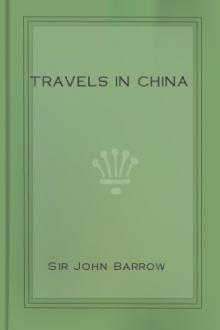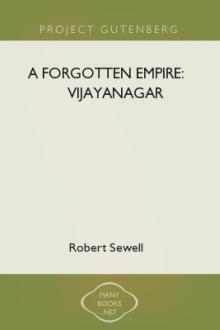Travels in China by Sir John Barrow (top e book reader .txt) 📕

[1] Monsieur (I beg his pardon) Citoyen Charpentier Cossigny.
Perhaps it may not be thought amiss, before he enters on the more immediate subject of the work, to correct, in this place, a very mistaken notion that prevailed on the return of the embassy, which was, that an unconditional compliance of Lord Macartney with all the humiliating ceremonies which the Chinese might have thought proper to exact from him, would have been productive of results more favourable to the views of the embassy. Assertions of such a general nature are more easily made than refuted, and indeed unworthy of attention; but a letter of a French missionary at Peki
Read free book «Travels in China by Sir John Barrow (top e book reader .txt) 📕» - read online or download for free at americanlibrarybooks.com
- Author: Sir John Barrow
- Performer: -
Read book online «Travels in China by Sir John Barrow (top e book reader .txt) 📕». Author - Sir John Barrow
Obscuris vera involvens."
"The wond'rous truths, involv'd in riddles, gave,
And furious bellow'd round the gloomy cave."
Lord Macartney observed that this singular temple brought to his recollection a Franciscan monastery he had seen in Portugal, near Cape Roxent, usually called the Cork Convent, "which is an excavation of considerable extent under a hill, divided into a great number of cells, and fitted up with a church, sacristy, refectory, and every requisite apartment for the accommodation of the miserable Cordeliers who burrow in it. The inside is entirely lined with cork: the walls, the roofs, the floors, are covered with cork; the tables, seats, chairs, beds, couches, the furniture of the chapel, the crucifixes, and every other implement, are all made of cork. The place was certainly dismal and comfortless to a great degree, but it wanted the gigantic form, the grim features, the terrific aspect which distinguish the temple of Poo-sa, in the rock of Quan-gin-shan." Dismal as this gloomy den appeared to be, where a few miserable beings had voluntarily chained themselves to a rock, to be gnawed by the vultures of superstition and fanaticism, it is still less so than an apartment of the Franciscan convent in Madeira, the walls of which are entirely covered with human skulls, and the bones of legs and arms, placed alternately in horizontal rows. A dirty lamp suspended from the ceiling, and constantly attended by an old bald-headed friar of the order, to keep the feeble light just glimmering in the socket, serves to shew indistinctly to strangers this disgusting memento mori. It would be difficult to determine which of the three were the most useless members of society, the monks of Poo-sa, the monks of the Cork convent, or the monks of Golgotha.
In several places among the wild and romantic mountains through which we were carried on this river, we noticed quarries of great extent, out of which huge stones had been cut for sepulchral monuments, for the arches of bridges, for architraves, for paving the streets, and for various other uses. To obtain these large masses, the saw is applied at the upper surface, and they work down vertically to the length required. Each stone is shaped and fashioned to the size that may be wanted, before it is removed from the parent rock, by which much difficulty is avoided and less power required in conveying it to its destination. Rude misshapen blocks, requiring additional labour for their removal, are never detached from the rock in such a state. In this respect they are more provident than the late Empress of Russia who, at an immense expense and with the aid of complicated machinery, caused a block of stone to be brought to her capital, to serve as a pedestal for the statue of the Czar Peter, where it was found expedient to reduce it to two-thirds of its original dimensions.
Between the city of Canton and the first pagoda on the bank of the river, there is a continued series of similar quarries, which appear not to have been worked for many years. The regular and formal manner in which the stones have been cut away, exhibiting lengthened streets of houses with quadrangular chambers, in the sides of which are square holes at equal distances, as if intended for the reception of beams; the smoothness and perfect perpendicularity of the sides, and the number of detached pillars that are scattered over the plain, would justify a similar mistake to that of Mr. Addison's Doctor of one of the German universities, whom he found at Chateau d'Un in France, carefully measuring the free-stone quarries at that place, which he had conceived to be the venerable remains of vast subterranean palaces of great antiquity.
Almost all the mountains that occurred in our passage through China were of primæval granite, some few of sand-stone, and the inferior hills were generally of lime-stone, or coarse grey marble. Except the Ladrone islands on the south, and some of the Chu-san islands on the east, we observed no appearances in the whole country of volcanic productions. The high mountains, indeed, that form great continental chains are seldom, if ever, of volcanic formation. The presence of a vast volume of water seems to be indispensably necessary to carry on this operation of nature and, accordingly, we find that volcanic mountains are generally close to the sea coast, or entirely insulated. Thus, although a great part of the islands on the coast of China are volcanic, we met with no trace of subterranean heat, either in volcanic products or thermal springs, on the whole continent. Yet earthquakes are said to have been frequently felt in all the provinces, but slight and of short duration.
About seven miles to the southward of the temple in the rock, the mountains abruptly ceased, and we entered on a wide extended plain which, to the southward and on each side, was terminated only by the horizon. This sudden transition from barrenness to fertility, from the sublime to the beautiful, from irregularity to uniformity, could not fail to please, as all strong contrasts usually do. The country was now in a high state of tillage; the chief products were rice, sugar-canes, and tobacco; and the river was so much augmented by the tributary streams of the mountains, which we had just left behind, that it was nearly half a mile in width. Canals branched from its two banks in every direction. At the city of San-shwee shien, we observed the current of the river receding, being driven back by the flux of the tide.
On the 10th, we halted before a village which was just within sight of the suburbs of Canton. Here the Embassador was met by the Commissioners of the East India Company, whom the Chinese had allowed to proceed thus far from the factory, and to which place the servants of the Company are occasionally permitted to make their parties of pleasure. In the neighbourhood of this village are extensive gardens for the supply of the city with vegetables. In some we observed nurseries for propagating the rare, the beautiful, the curious, or the useful plants of the country; which are sent to Canton for sale. On this account we were not sorry to be obliged to spend the remainder of the day at this place. Among the choice plants we noticed the large Peonia before mentioned, white, red, and variegated; the elegant Limodorum Tankervilliæ, and that singular plant the Epidendrum flos aeris so called from its vegetating without the assistance of earth or water; the Hybiscus mutabilis, the Abelmoschus, and other species of this genus; the double variegated Camellia Japonica; the great holly-hock; the scarlet amaranthus and another species of the same genus, and a very elegant Celosia or cock's comb; the Nerium Oleander, sometimes called the Ceylon rose, and the Yu-lan, a species of magnolia, the flowers of which appear before the leaves burst from the buds. Of the scented plants the plumeria and a double flowering jasmine were the most esteemed. We observed also in pots the Ocymum or sweet Basil, Cloranthus inconspicuous, called Chu-lan, whose leaves are sometimes mixed with those of tea to give them a peculiar flavour; the Olea fragrans, or sweet scented olive, said also to be used for the same purpose; a species of myrtle; the much esteemed Rosa Sinica; the Tuberose; the strong scented Gardenia florida, improperly called the Cape Jasmine; the China pink and several others, to enumerate which would exceed the limits of this work.
Of fruits we noticed a variety of figs, and three species of mulberries; peaches and almonds; the Annona or custard-apple; the Eugenia Jambos, or rose-apple; the much-esteemed Lee-tchee or Sapindus-edulis; and the Kœlreuteria, another species of the same genus; the Averhoa Carambola, an excellent fruit for tarts; and the Ou-long-shoo, the Sterculia platanifolia. Besides these were abundance of oranges and bananas.
As vegetables for the table, was a great variety of beans and calavances, among which was the Dolichos Soja or soy plant, and the polystachios, with its large clusters of beautiful scarlet flowers; the Cytisus Cadjan, whole seed yields the famous bean-milk, which it is the custom of the Emperor to offer to Embassadors on their presentation; large mild radishes, onions, garlic, Capsicum or Cayenne-pepper; convolvulus batatas, or sweet potatoes; two species of tobacco; Amomum, or ginger, in great quantities, the root of which they preserve in syrup; Sinapis, or mustard, and the Brassica orientalis, from which an oil is expressed for the table.
Of plants that were useful in the arts, we observed the Rhus vernix, or varnish-tree, and two other species of the same genus; Curcuma, or turmeric; Carthamus used as a dye, and the polygonum Chinense for the same purpose; the Rhapis flabelliformis, the dried leaves of which are used for fans among the common people, and particularly by those who live in vessels; Corchorus whose bark, in India, is used as flax; but not, I believe, to any extent in China, the white nettle being here preferred. The only medicinal plants were the Rheum palmatum, Artemisia, and the Smilax or China root.
To make our entré into Canton the more splendid, a number of superb barges were sent to meet us, carrying flags and streamers and umbrellas and other insignia of office; and in some were bands of music. About the middle of the day we arrived before the factories, which constitute a line of buildings in the European style, extending along the left bank of the river, where the Embassador was received by the Song-too, or Viceroy, the Governor, the Ho-poo, or collector of the customs, and all the principal officers of the government. From hence we were conducted to the opposite side of the river, where a temporary building of poles and mats had been prepared for the occasion; within which was a screen of yellow silk bearing the name of the Emperor in gilt characters. Before this screen the Viceroy and other officers performed the usual prostrations, in token of gratitude to his imperial Majesty, for his having vouchsafed us a prosperous journey.
It is but doing justice to the Chinese government and to the individuals in its employ who had any concern in the affairs of the embassy, to observe, that as far as regarded ourselves, their conduct was uniformly marked by liberality, attention, and an earnest desire to please. Nor is there any vanity in saying that, after observing us closely in the course of a





Comments (0)